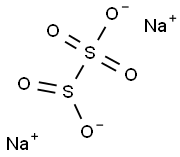A7320112
Sodium pyrosulfite , ≥99% , 7681-57-4
Synonym(s):
E223;Natrii metabisulfis;Sodium disulfite;Sodium metabisulfite;Sodium pyrosulfite
CAS NO.:7681-57-4
Empirical Formula: 2Na.O5S2
Molecular Weight: 190.11
MDL number: MFCD00213787
EINECS: 231-673-0
| Pack Size | Price | Stock | Quantity |
| 100g | RMB34.40 | In Stock |
|
| 500G | RMB132.80 | In Stock |
|
| 2.5KG | RMB370.40 | In Stock |
|
| 10kg | RMB1062.40 | In Stock |
|
| others | Enquire |
Update time: 2022-07-08
PRODUCT Properties
| Melting point: | >300 °C (lit.) |
| Density | 1.48 |
| bulk density | 1000-1200kg/m3 |
| refractive index | 1.474 |
| storage temp. | Store at +5°C to +30°C. |
| solubility | 540 g/L (20°C) |
| form | Powder/Solid |
| Specific Gravity | 1.48 |
| color | White to slightly yellow |
| PH | 3.5-5 (50g/l, H2O, 20℃) |
| Odor | Sulphorous |
| PH Range | 4.5 at 50 g/l at 20 °C |
| Water Solubility | 540 g/L (20 ºC) |
| Sensitive | Air & Moisture Sensitive |
| Merck | 14,8638 |
| Exposure limits | ACGIH: TWA 5 mg/m3 NIOSH: TWA 5 mg/m3 |
| Stability: | Stable. Incompatible with strong oxidizing agents, strong acids. Contact with strong acids releases a poisonous gas. May be moisture and air sensitive. |
| InChIKey | HRZFUMHJMZEROT-UHFFFAOYSA-L |
| CAS DataBase Reference | 7681-57-4(CAS DataBase Reference) |
| EPA Substance Registry System | Sodium metabisulfite (7681-57-4) |
Description and Uses
Sodium Metabisulfite is a preservative and antioxidant that exists as crystals or powder having a sulfur dioxide odor. it is readily solu- ble in water. it is used in dried fruits to preserve flavor, color, and to inhibit undesirable microorganism growth. it prevents “black spots” due to oxidative deterioration in shrimp. it is used in maraschino cherries. it is found in lemon drinks as a preservative. see sulfur dioxide.
Safety
| Symbol(GHS) |   GHS05,GHS07 |
| Signal word | Danger |
| Hazard statements | H302-H318 |
| Precautionary statements | P264-P270-P280-P301+P312-P305+P351+P338-P501 |
| Hazard Codes | Xn,Xi |
| Risk Statements | 22-31-41-36/37/38-52 |
| Safety Statements | 26-39-46-36-16 |
| RIDADR | 3260 |
| OEB | B |
| OEL | TWA: 5 mg/m3 |
| WGK Germany | 1 |
| RTECS | UX8225000 |
| TSCA | Yes |
| HS Code | 2832 10 00 |
| PackingGroup | III |
| Hazardous Substances Data | 7681-57-4(Hazardous Substances Data) |
| Toxicity | LD50 orally in Rabbit: 1540 mg/kg LD50 dermal Rat > 2000 mg/kg |



